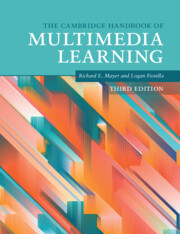Book contents
- The Cambridge Handbook of Multimedia Learning
- The Cambridge Handbook of Multimedia Learning
- Copyright page
- Contents
- Figures
- Tables
- Contributors
- Preface
- Acknowledgments
- Part I Background
- Part II Theoretical Foundations
- Part III Basic Principles of Multimedia Learning
- 11 The Multimedia Principle
- 12 The Multiple Representations Principle in Multimedia Learning
- 13 The Expertise Reversal Principle in Multimedia Learning
- Part IV Principles for Reducing Extraneous Processing in Multimedia Learning
- Part V Principles for Managing Essential Processing in Multimedia Learning
- Part VI Principles Based on Social and Affective Features of Multimedia Learning
- Part VII Principles Based on Generative Activity in Multimedia Learning
- Part VIII Multimedia Learning with Media
- Author Index
- Subject Index
- References
11 - The Multimedia Principle
from Part III - Basic Principles of Multimedia Learning
Published online by Cambridge University Press: 19 November 2021
- The Cambridge Handbook of Multimedia Learning
- The Cambridge Handbook of Multimedia Learning
- Copyright page
- Contents
- Figures
- Tables
- Contributors
- Preface
- Acknowledgments
- Part I Background
- Part II Theoretical Foundations
- Part III Basic Principles of Multimedia Learning
- 11 The Multimedia Principle
- 12 The Multiple Representations Principle in Multimedia Learning
- 13 The Expertise Reversal Principle in Multimedia Learning
- Part IV Principles for Reducing Extraneous Processing in Multimedia Learning
- Part V Principles for Managing Essential Processing in Multimedia Learning
- Part VI Principles Based on Social and Affective Features of Multimedia Learning
- Part VII Principles Based on Generative Activity in Multimedia Learning
- Part VIII Multimedia Learning with Media
- Author Index
- Subject Index
- References
Summary
The multimedia principle is that people learn better from words and pictures than from words alone. For example, a multimedia lesson consists of an animation depicting the steps in lightning formation along with concurrent narration describing the steps in the lightning formation, whereas a single-medium lesson consists of narration alone. Based on research carried out by myself and my colleagues, in 13 out of 13 tests, learners who received text and illustrations or narration and animation (dual representation group) performed better on transfer tests than did learners who received text alone or narration alone (single representation group), with a median effect size of d = 1.35.
Keywords
- Type
- Chapter
- Information
- The Cambridge Handbook of Multimedia Learning , pp. 145 - 157Publisher: Cambridge University PressPrint publication year: 2021
References
- 7
- Cited by

